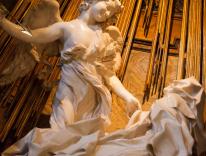 First, Benedict XVI confirms that tests done on bone fragments from a tomb venerated as that of theApostle--but often considered more legend than fact--belonged to a man who lived between the first and second century.
First, Benedict XVI confirms that tests done on bone fragments from a tomb venerated as that of theApostle--but often considered more legend than fact--belonged to a man who lived between the first and second century.
“This seems to confirm the unanimous and uncontested tradition that they are the mortal remains of the Apostle Paul,” the pope said during an evening prayer service June 28 at Rome’s Basilica of St. Paul Outside the Walls, according to the CNS report.The basilica has long been held to be the burial site of St. Paul, but because of the destruction and rebuilding of the basilica, the exact location of the tomb was unknown for centuries. Vatican officials announced in December 2006 that several feet below the basilica’s main altar and behind a smaller altar, they had found a roughly cut marble sarcophagus beneath an inscription that reads: “Paul Apostle Martyr.“Because part of the sarcophagus is buried beneath building material, Vatican officials determined they could not dig it out to open and examine the contents. Initially they tried to X-ray it to see what was inside, but the marble was too thick.Pope Benedict said a “very tiny perforation” was drilled into the marble so that a small probe could be inserted in order to withdraw fragments of what was inside.In addition to traces of purple linen, a blue fabric with linen threads and grains of red incense, he said they found bone fragments.The bone fragments “underwent a carbon-14 analysis carried out by experts who did not know their place of origin,” the pope said, adding that the results “indicate they belong to a person who lived between the first and second century.”
Second, and just as remarkable, is the news that Vatican archaeologists have foundwhat is likely the oldest known portrait of St Paul--a fourth-century mosaic (shown above, from the London Times story) that shows the Apostle to the Gentiles much as he has been portrayed down through the centuries.
L’Osservatore Romano, the Vatican newspaper, which devoted two pages to the discovery, said that the oval portrait, dated to the 4th century, had been found in the catacombs of St Thecla, not far from the Basilica of St Paul’s Outside the Walls, where the apostle is buried. The find was “an extraordinary event”, said Monsignor Gianfranco Ravasi, head of the Pontifical Council for Culture.Barbara Mazzei, a restorer, said that centuries of grime had been removed with a laser. Fabrizio Bisconti, Professor of Christian Iconography at Rome University and a member of the team that made the discovery, said that it appeared to have decorated the tomb of a nobleman or high church official.
